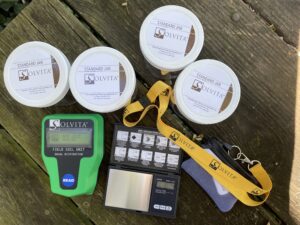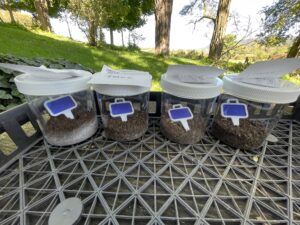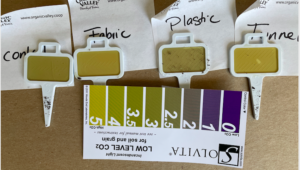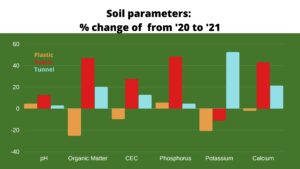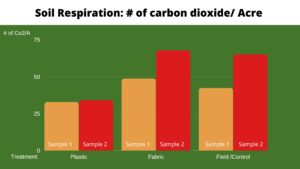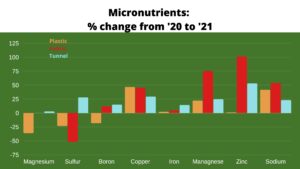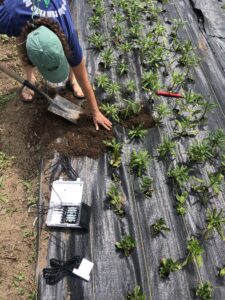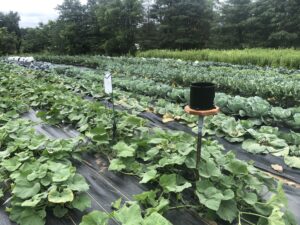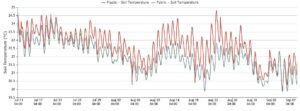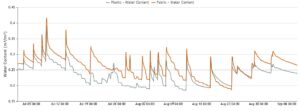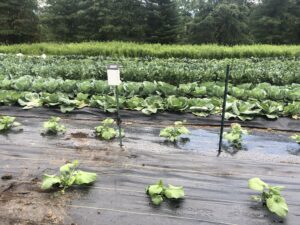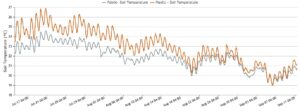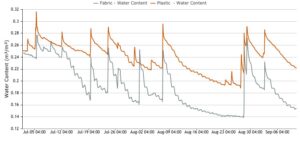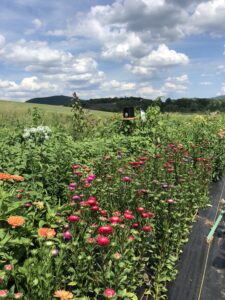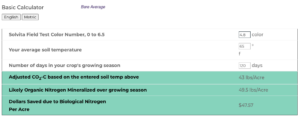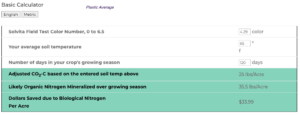Final report for FNE20-949
Project Information
Our project demonstrated the use of landscape fabric on 2 Pennsylvania farms, and collected data on soil health comparing landscape fabric to control treatments of black plastic, and bare ground. Time involved with weeding, preparing, installing and removing landscape fabric was tracked to demonstrate economic and quality of life impact. Data on soil moisture/temperature, changes in pH/organic matter and indicators of soil health including soil respiration was collected to demonstrate differences between treatments.
Data collected indicated that soil temperature is generally close to 1-2 degrees warmer under the plastic mulch than the landscape fabric. Soil moisture data is inconclusive and would further data set to demonstrate rain versus drip irrigation effects. Soil respiration test results indicated microbial activity was highest under the landscape fabric, which reassured me that microbial soil health was not compromised under this system.
Project results indicate that landscape fabric is effective at reducing weed pressure, reducing overall management for weed control since walkways are generally also covered. Labor required for preparation and installation of the landscape fabric was more than the plastic mulch, which was faster but also required tractor and plastic layer equipment. Removing landscape fabric at the end of the season was easier than removing the plastic mulch, and it was a great relief to know the fabric would be used for years to come, instead of going to a landfill
This project will demonstrate the effectiveness of landscape fabric in mixed produce and cut flower production on two Pennsylvania farms and its effects on soil health and soil parameters. We will collect data to demonstrate the effect that the use of landscape fabric has on soil moisture and temperature, as well as soil biology, soil respiration and pH & organic matter. Data will also be collected on time spent preparing, installing and removing the landscape fabric, as well as time spent weeding. Although farmers claim anecdotal increases in temperature and soil moisture, there is no current research on this, or the range of increase to be expected. With results from this project, farmers will be able to make a more informed decision on the use of landscape fabric as they evaluate methods to reduce weeds, tillage and use of non-renewable resources such as black plastic.
The past several years have seen a rapid increase in the use of landscape fabric by both small scale and urban ag producers, and is promoted by leaders in the growing local flower movement, such as Floret (floretflowers.com), as well as respected seed suppliers such as JohnnySeeds (johnnyseeds.com). Previously landscape fabric was more commonly used for ornamental landscape purposes, or for perennial crops. More recently it is being used for annual crops as part of reduced, or even no-till production system. It is generally removed from the field at the end of the season to be used for several years, allowing soil amendments to be applied and crops to be rotated. The collapse of the plastic recycling industry means that black plastic mulch is now destined for landfill disposal year after year, whereas landscape fabric which is removed and stored at the end of each growing season is expected to have a lifespan of 10 years.
Although our flower farm has relied on the use of black plastic mulch for many years, I have found that it required additional tillage in the spring to get the soil to the right consistency to effectively install the plastic mulch with our three point hitch mulch layer and found the weed control between rows to be an ongoing problem. To control weeds between the beds we tried mulching with round bales of straw/hay, seeding cover crops and tillage/handweeding, and found none of them to be effective for the entire season. Due to ever increasing concerns with the use of plastic mulch, the fact that it cannot be recycled, and to reduce tillage, I used landscape fabric for the first time in the 2019 season. We overlapped the landscape fabric between beds, so there were no bare walkways. This season was the first time I ever felt the weed control in my cut flower beds was acceptable, and the beds safe enough to be suitable for Pick-your-own. Due to successful weed control provided by the landscape fabric our farm was able to host two successful PYO flower days.
An informal 2019 survey of members of the Association of Cut Flower Growers (ASCFG) regarding their use of landscape fabric provided the following anecdotal comments:
- The biggest chore for a flower farmer is weeding and fabric makes it manageable.
- It is undeniably a main reason why we are able to produce the quality and quantity that we are able to, for it's weed suppression and water retention qualities.
- We have used landscape fabric for all of the years that we have been growing cut flowers. As a small sized farm we would not be in business without it. We do all weeding by hand and this allows us to do something other than weeding, like growing and selling flowers.
- I would not be able to farm without woven ground cloth, outside beds and tunnel beds. It's a game changer for labor costs. Granted, you have a lot of "up front" you need to do before you plant. Amend the soil, compost, lay down your drip irrigation, place cloth and plant. Sometimes the prep makes things go slowly. I have cloth with various spaced holes for crops. For crops that can be direct sowed, I don't use the cloth - but I always use cloth in the paths. I have never had issues with over-heating - but my drip is on timed irrigation so the soil is always moist.
- One other major benefit for us is that it helps warm up the soil in the spring, and some protection from our volatile spring weather.
- We have not used it yet, but are still considering it. Worries: will heat the ground too much, breakthrough weeds, wind, labor intensive, storage, more plastic, investment costs. Pros we think: less weeding we hope, less erosion, moisture retention.
Our on farm demonstration will track time spent in preparing, installing and removing the landscape fabric, as well as tracking time spent weeding. Less time spent weeding is not only an economic benefit, it also opens up new marketing opportunities, such as Pick-your-own operations.
Our project will collect data on soil moisture/temperature, changes in pH/organic matter and indicators of soil health including soil respiration to demonstrate differences between landscape fabric, and controls of plastic mulch/bare ground on two different farms with different soil types.
Our farm is about 60 acres, although we cultivate generally less than an acre. The rest of the farm is in hayfields, pasture, woods and wildlife habitat. We have farmed at our current location for 20 years. While we started as a mixed produce operation, we switched to mostly cut flower production about ten years ago. In addition to cut flowers, we also raise hay crops, as well as livestock, including pastured poultry, and grass-fed beef. We have tractors, rototiller and plastic layer machinery that will be used for this project. We have access to a well for irrigation. We farm part-time, and our current sales are through farmers' market sales, event flowers, as well as weekly bouquet subscriptions. Although our farm was certified organic for many years, we are no longer certified, but continue farming according to organic practices.
Cooperators
Research
Two local farms (Farm 1 - mixed produce, Farm 2 - cut flower farm) demonstrated and evaluated the use of landscape fabric versus black plastic in their operation.
Both farms installed and maintained:
- 2 rows of new 6'by 300' DeWitt/Sunbelt landscape fabric.
- 1 row of black plastic mulch
Both sites received compost from the same source and applied it at the rate of 2" per acre.
Drip irrigation was installed underneath the landscape fabric. Landscape fabric was laid by hand and held down by staples. Plastic mulch was laid by a tractor-mounted plastic layer.
Video: Plastic mulch Layer in action
General observations were maintained on weed pressures. At Farm 1 the plastic and landscape mulches overlapped, so there was no necessary weed management needed in walkway. At Farm 2, there was a bare walkway between the fabric and plastic mulch, which was seeded with a legume, brassica, broadleaf mix.
A set of soil tests were taken in July 2020 at both farms in all treatments, tracking pH, organic matter and macronutrients. A second set of soil tests was taken in September 2021 at Farm 2 for comparison.
Mulch treatments preparation
Holes were burned into the landscape fabric using a handheld benzomatic propane burner and a set of wooden templates.
For cut flower production at Farm 2, three different templates were used: 6” by 6” spacing, 9” by 9” spacing, 12” by 12" spacing - see image. Hole size was 2” across, which was on the small side when trying to plant plugs into it.
For winter squash at Farm 1, holes were spaced 36” apart and were ca. 3” in diameter.
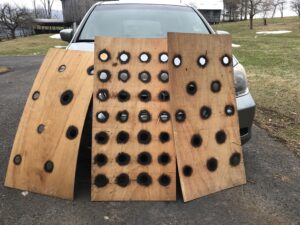
Time spent burning 300’ roll averaged 2-3hours depending on which template was used. Closer spacing means more holes, which takes longer. The 9” by 9” template took 3 hours to burn.
See video:
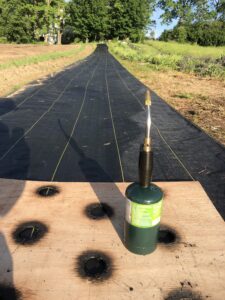 Burning holes into fabric with propane burner
Burning holes into fabric with propane burner
Video: Burning holes in landscape fabric
Burning the holes was done outside of the growing area, as little bits of fabric melt off and are left behind.
Landscape fabric was laid down manually and secured along the edges and within the bed with 6” staples to prevent shifting.
In windy locations, it is important to anchor the fabric as much as possible to prevent any possible side to side movement and shifting, as there is the potential for the fabric to shear off or damage stems on tender transplants. Once plants are settled in and canopy establishment starts the fabric is held in place firmly and shifting is generally no longer a concern.
Plastic mulch was laid with tractor-mounted plastic layer. Time spent for 300’ row less than 30 minutes, includes laying of one row of drip tape, plus tucking in both ends manually.
At Farm 2 a cover crop was seeded on the walkway next to the plastic row, but stand establishment was poor due to the heat and drought during 2020.
Soil Respiration:
Soil respiration is an indicator of microbial activity and soil biological response. Date was collected in September 2021 at Farm 2 on two separate days, to document variations between plastic, landscape fabric, high tunnel (elevated temperatures) and bare ground. A Solvita Field test kit was used, which reports values of CO2-output in pounds per acre
Samples were collected randomly in each treatment, and they were minimally sieved to remove stones, roots and any living creatures. Each sample was weighed to 90 grams, and placed in an airtight collection jar, along with a sensor paddle, for 24 hours.
Data Collection:
Soil temperature and moisture were collected at 15-minute intervals via Zentra Teros 11 sensors installed within the row below the soil surface, below the mulched area. Data were collected and stored on solar-powered data loggers.
Rainfall was monitored at both sites via Rainwise raingauges and data stored on Rainlog 2.0 data loggers
Data collection started July 1, 2020, at both locations
Data collection ended on September 9, 2020 ( winter squash harvest) at Farm 1 and January 3, 2021, at Farm 2
Both plastic and fabric treatments required initial manual hand-weeding of the holes, but once plants were established and a canopy was formed no additional hand weeding was performed.
There was no significant difference observed in weed management required between the treatments, other than increased weed pressure in the walkways at Farm 2, due to poor establishment of walkway seeding in drought.
Farm 1
Soil temperatures
Soil moisture
|
|
Min temp |
Max temp |
Min water |
Max water |
||
|
Farm 1 Plastic |
19.9 |
28.3 |
0.189 |
0.401 |
||
|
Farm 1 Fabric |
19.9 |
26.4 |
0.185 |
0.413 |
Farm 2
Soil temperature
Soil moisture
|
Treatment |
Min temp C |
Max temp C |
Min water |
Max water |
||
|
Farm 2 Plastic |
19 |
27.4 |
0.19 |
0.321 |
||
|
Farm 2 Fabric |
19.1 |
25.6 |
0.14 |
.305 |
Time spent with mulch preparation and installation:
Fabric mulch - burning of holes:
Plastic mulch - holes were created with a trowel at the time of planting. No additional time was calculated for this.
Installation of landscape fabric was about 90 minutes per 300' roll, lay it out and secure with staples.
Installation of plastic mulch using a tractor-mounted mulch layer takes about 15 minutes per 300' row, including burying and tucking in the ends.
Removal of fabric mulch at the end of the season was faster and cleaner than the plastic, as the edges are not buried under soil. Fabric landscape is rolled up and re-used from year to year, whereas plastic mulch is single-use and must be disposed of in the landfill. There are currently no recycling options for plastic mulch in our county (Centre County, PA).
2020 Soil tests taken did not demonstrate any consistent treatment pattern and were repeated at Farm 2 in 2021
Soil Respiration
Solvita soil respiration test results taken at Farm 2 on two separate days under landscape fabric, under plastic mulch, and in bare ground as a control , indicated the following results. Nitrogen mineralization, indicated by soil respiration and microbial activity was the highest in the landscape fabric treatment, with 53# N/Acre, bare ground control was 49.5#/Acre and the plastic mulch showed the least microbial activity with 35.5# N/Acre.
Changes from the original plan
The initial plan was to collect this data on three farms, but one of our farmers left the area spring of 2020 before the trial started.
Our original plan had to be adjusted due to many unforeseen circumstances that the COVID pandemic and spring lockdown brought, including delays in deliveries and installation of equipment, delivery of compost. Our outreach plans originally included a field day, which conflicted with COVID protocol in our area and had to be removed from the plan.
Testing Protocol: We were only able to perform one set of soil tests instead of two per season. Soil microbial health tests were not performed as planned during the 2020 season. The landscape fabric and plastic mulch were left in place over the winter 20/21 at Farm 2, so that testing of both microbial soil health parameters and soil tests in Spring 2021 could be completed as a final comparison.
Noteworthy conditions
The 2020 season started with an unusually cold spring, followed by a record-breaking drought and heat all summer long.
The 2021 season was characterized by a wet summer and fall, with periodic flooding.
Data collected indicated that soil temperature is generally close to 1-2 degrees warmer under the plastic mulch than the landscape fabric. Soil moisture data is inconclusive and would further data set to demonstrate rain versus drip irrigation effects. Soil respiration test results indicated microbial activity was highest under the landscape fabric, which reassured me that microbial soil health was not compromised under this system.
Project results indicate that landscape fabric is effective at reducing weed pressure, reducing overall management for weed control since walkways are generally also covered. Labor required for preparation and installation of the landscape fabric was more than the plastic mulch, which was faster but also required tractor and plastic layer equipment. Removing landscape fabric at the end of the season was easier than removing the plastic mulch, and it was a great relief to know the fabric would be used for years to come, instead of going to a landfill.
We're pleased with the results and will be switching to landscape fabric for all our annual mulching needs, saving us much labor in weed control, and reducing tillage. By having cleaner fields we will be able to explore more marketing options, such as pick-your-0wn events.
Education & Outreach Activities and Participation Summary
Participation Summary:
One article was written for distribution to trade publications and magazines, farmer educators.
Landscape Fabric versus Plastic Mulch
One Webinar with more detailed results to be presented through PASA summer/fall 2022.
Learning Outcomes
Utilizing landscape fabric is an effective way to improve weed control, reduce labor, and minimize tillage on diversified vegetable & flower farms, while having a positive effect on nitrogen mineralization.
Project Outcomes
This project confirmed that the use of landscape fabric results in reduced inputs, as well as playing a positive role in moisture management and soil health due to reduced tillage.
Assessment - it would have been helpful to have a longer testing period to take seasonal and annual variations into consideration. Collecting long term data from plots comparing fabric, plastic mulch and bare ground. It also proved more difficult than expected to monitor irrigation/rainfall.
After completing this study and reviewing the results I am ready to sell my plastic mulch layer tractor attachment and move to landscape fabric permanently. I think the knowledge gained from this study will benefit small scale crops/flower/specialty crops in the Northeast. I am not sure if temperature variations could be interpreted the same way in growing areas that have hot summers.
Information Products
- Landscape Fabric versus plastic mulch - why our flower farm is selling our mulch layer (Article/Newsletter/Blog)
